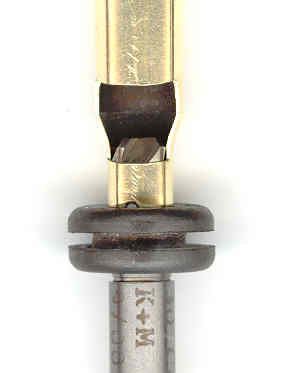|
|
|
Reloading Forum >
Minimum Neck Tension
Minimum Neck Tension
< Check Out the NEW Turkey SHOOT Contest!
Page:
1
Jerry
4 posts
Oct 07, 2004
2:28 PM

|
I noticed a variation in seating effort seating 107 SMK's into my 6BR. The cases had been run through a .268 neck bushing and are in good shape dimentionally. They have been fired about 6 times. I assumed the change was due to differences in hardening from firing. (lapua cases).Neck sizing only. I made an expanding mandrel on the lathe that reduces neck tension to about .0005". The seating effort is now exactly the same on each round (say light!). The bullets can not be turned by hand and shoot well.
However....folks on this site have stated that you need a minimum of .002 or so to avoid velocity spreads.Is there some minimum resistance required for other reasons than uniform neck tension? Pressure generation?
Load is 31 grs. varget, CCI 450 primers.
|
Moderator
68 posts
Oct 08, 2004
10:05 AM

|
Some loads work best with as little as .001" tension (based on difference between bushing diameter and neck diam. of loaded round), while others work well with much more tension. Normally though, .001-.002" is where you want to be. Superlight tension can be very accurate, as the 6PPC crowd has shown, but the practical problem you have is that the bullet may pull out when you extract a loaded round. Then you've got a real mess.
The problem in bullet seating you describe is probably due to a couple factors. One, as you observed, the necks are stiffening as they getted cold-worked during successive reloadings. Annealing can help restore the original ductility. Second, you may be seeing the effect of brass flowing into the neck-shoulder junction (NSJ) area. During firing, brass flows up into the NSJ, building up on the outside as well as the inside (the "dreaded doughnut"). Moreover, repeated neck-sizing with bushings tends to push brass down to the NSJ. So you get a bulge on the outside and a doughnut on the inside.
The remedy is to do as you did but less radically. You can use an expander mandrel to open up the neck interior. Then outside neck-turn the last third to quarter of the necks. Make sure you cut up into the shoulder about .030". The K&M neck-turning tool has an angled cutter to permit a shoulder cut. At the same time, you can use the K&M tool (with optional carbide mandrel) to cut away any part of the doughnut that wasn't pushed out by the expander. Once you've removed the excess brass in the NSJ, and turned the bottom part of the neck, you will find that the bullets seat much more consistently. Your ES and SD should drop as well.
Many shooters like to set their throats so the full diameter of the bullet never gets closer than .050" or so to the doughnut area. (I.e. keep the base of a flat-based bullet, or the top of the tail on a BT bullet, at least .050" above the NSJ). This is a good idea, because it will allow you more firings without having to expand and turn cases. Here is a photo of the K&M doughnut-removing mandrel with its carbide cutting tip. (The rubber ring is not part of the tool).

|
jb1000br
1000yd Editor
15 posts
Oct 08, 2004
11:30 AM

|
Jerry--use what works--I use 0.0007" tension on my 6.5. and even with that, i have to load the rounds at least 24hrs ahead of time or i get vertical at 1k.
the more tension, the more vertical for me!!
just watch what was said about the rifling pulling the bullet out. although, i am healthily in the lands and havent pulled a bullet yet.
JB
|
Post a Message

|
|